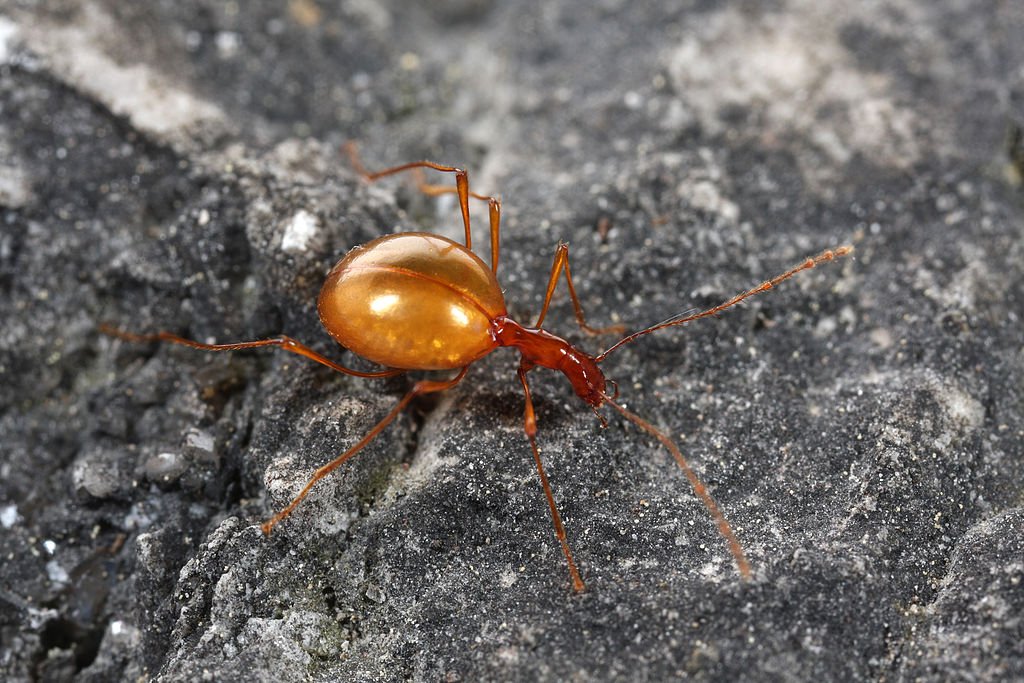Welcome to another post of my strange animals series where you get to meet some of the weirdest, coolest, and craziest animals on a daily basis!
Ever wondered what kind of creepy creatures lurk deep inside the earth's bosom? What dark secrets these caves withhold? Well, it is true that your imagination can go wild on this, but don't expect to find human-eating dragons or blood-thirsty bats.
Variety down there is wide and most of these creatures are quite weird-looking as a result of the evolutionary adaptations, forced to them by the absence of light and continuous food shortage.
Today's post is about one of those weirdos...and not just any weirdo. Meet, the narrow-necked blind cave beetle, the first animal officially described to live exclusively in a cave:
 L. hochenwartii from a cave in the Inner Carniola region, Slovenia (credit, CC BY-SA 3.0)
L. hochenwartii from a cave in the Inner Carniola region, Slovenia (credit, CC BY-SA 3.0)
That's one weird-looking beetle don't you agree? It actually looks more like a honey-pot ant or something!
Now, let's learn more about this critter, starting like always with a quick history lesson:
The Discovery of Leptodirus hochenwartii and Why It was so Important
The blind cave beetle is known to man for a long time now. It was first found in September 1831 by cave guide and lamp man, Luka Čeč, who picked up one while exploring a newly discovered inner portion of the Postojna cave system in southwestern Slovenia.
Although Čeč came from a poor education background, he was smart enough to recognize he was holding something really important in his hands! Sometime later, Čeč gave the specimen to count Franz Josef von Hochenwartenough who at the time was preparing the first printed guide about Postojna cave. He was also unable to identify the species and gave it to Ferdinand J. Schmidt, a famous entomologist from Ljubljana.

Ferdinand Jožef Schmidt (credit, public domain)
Schmidt, being an expert and all, recognized the beetle to be a new species and described it in his paper Illyrisches Blatt [1]. His article is the first formal description of an animal living exclusively in a cave. Back then, this was a HUGE thing for science because the caves were not considered to be a suitable habitat for any kind of organism, animal or plant.
I would also like to add Schmidt later discovered many other unknown cave inhabitants, becoming a pioneer in Biospeleology, a branch of biology dedicated to the study of organisms that live in caves and are collectively referred to as troglofauna.

(credit)
Tell Me More About The Creature!
I would love to, but unfortunately there is not much to tell. There has been very little research on it and as a result we know very little about it.
Here's a breakdown of what we know:
- Distribution & Habitat: The species is endemic to the western Dinaric Alps, found in caves of Slovenia and Croatia. It is a true troglobite, adapted to living exclusively underground and unable to survive outside. It's most common in large caves where the temperature does not exceed 12 °C.
- Morphology: The species has elongated legs and antennae, reduced eye and a slender thorax. The most distinguishing characteristic is the domed elytrae which cover the abdomen completely and give it a round ("physogastric") appearance
- Lifecycle: Largely a mystery. All we know is that it reproduces and grows slowly. Females lay a small number of relatively large eggs which also take long time to develop.
- Diet: It has been reported to feed on the carcasses of various cave animals and other organic matter.
- Conservation Status: At the moment, the species is considered to be rare and vulnerable due to its limited range and slow reproduction. It s is included in the Slovenian Red list of threatened species (category R) and in the Annex II of the EU Habitats Directive (92/43/EEC). Today, 15 areas of conservation are established in Slovenia which include the majority of the caves it occurs, ensuring its' long term survival.

(credit)
So that's pretty much all we know! A final thing I want to mention is that there are 6 recognized subspecies:
- L. hochenwartii hochenwartii Schmidt, 1832
- L. hochenwartii reticulatus J. Müller 1906
- L. hochenwartii schmidti (Motschoulsky, 1856)
- L. hochenwartii croaticus Pretner, 1955
- L. hochenwartii velebiticus Pretner, 1970
- L. hochenwartii pretneri Müller, 1926
Hope you enjoyed reading about the narrow-necked cave beetle! See you in my next strange animals post :)

(credit)
Note
In some photos the beetle appears to have more bright colors than it actually does. This is due to the flash. When the flash fires, the head and the thorax appear reddish due to reflection (the exoskeleton is very thin and almost translucent).
References
- Schmidt F. "Beitrag zu Krein's Fauna". Illyrisches Blatt nr. 3, 21 January 1832. Digitized version at the Digital library of Slovenia. (in German)
- Importance of discovery of the first cave beetle
- Wikipedia.org/wiki/Leptodirus_hochenwartii

My dear readers, thank you for reading today's article. Hopefully, you found it interesting enough to follow me, @trumpman, if you want to discover more weird and bizarre creatures from all around the word! Here are the last 5 weirdos of this series:
- Paedophryne amauensis: Meet the World's Smallest Frog
- The King of Herrings: Horrifying, yet Harmless
- Slimy Jewels: 11+1 Nudibranchs That Will Blow Your Mind
- Cebrennus rechenbergi: The Spider That Wanted To Be A Gymnast
- Beauty Stings: The Stinging Rose Moth Caterpillar
Steemstem
Interested in science? Please, don't forget to check the @steemstem project, a community-driven project meant to promote well-written, high-quality, STEM-related content (STEM as for Science, Technology, Engineering and Mathematics). Just click here to join us!
Greek Community
A big thanks goes to my fellow greeks who support me with their love! You guys rock! A special mention also goes to @rouketas and @skapaneas for bringing us all together! I love you guys all :)
